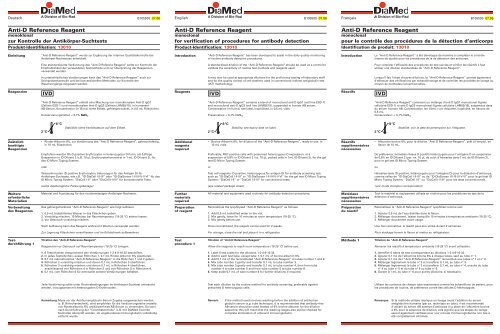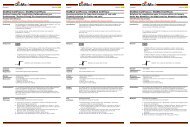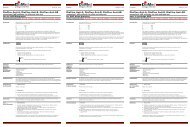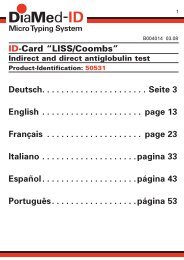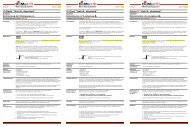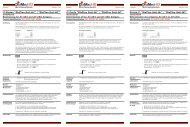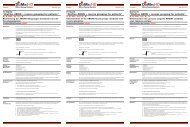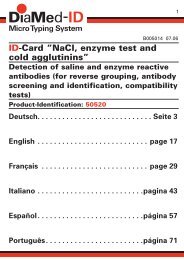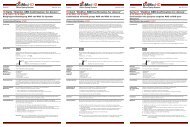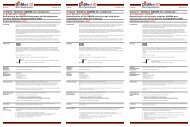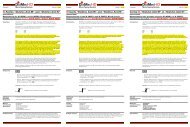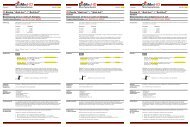Anti-D Reference Reagent Anti-D Reference Reagent Anti-D ...
Anti-D Reference Reagent Anti-D Reference Reagent Anti-D ...
Anti-D Reference Reagent Anti-D Reference Reagent Anti-D ...
Create successful ePaper yourself
Turn your PDF publications into a flip-book with our unique Google optimized e-Paper software.
Deutsch B105500 07.06 English B105500 07.06 Français B105500 07.06<br />
<strong>Anti</strong>-D <strong>Reference</strong> <strong>Reagent</strong><br />
monoklonal<br />
zur Kontrolle der <strong>Anti</strong>körper-Suchtests<br />
Produkt-Identifikation: 13010<br />
<strong>Anti</strong>-D <strong>Reference</strong> <strong>Reagent</strong><br />
monoclonal<br />
for verification of procedures for antibody detection<br />
Product-Identification: 13010<br />
<strong>Anti</strong>-D <strong>Reference</strong> <strong>Reagent</strong><br />
monoclonal<br />
pour le contrôle des procédures de la détection d‘anticorps<br />
Identification de produit: 13010<br />
Einleitung<br />
“<strong>Anti</strong>-D <strong>Reference</strong>-<strong>Reagent</strong>” wurde zur Ergänzung der internen Qualitätskontrolle bei<br />
<strong>Anti</strong>körper-Nachweisen entwickelt.<br />
Introduction<br />
“<strong>Anti</strong>-D <strong>Reference</strong>-<strong>Reagent</strong>” has been developed to assist in the daily quality monitoring<br />
of routine antibody detection procedures.<br />
Introduction<br />
Le “<strong>Anti</strong>-D <strong>Reference</strong>-<strong>Reagent</strong>” a été développé de manière à compléter le contrôle<br />
interne de qualité pour les procédures de la de détection des anticorps.<br />
Eine standardisierte Verdünnung des “<strong>Anti</strong>-D Referenz-<strong>Reagent</strong>” sollte zur Kontrolle der<br />
Empfindlichkeit der verwendeten Testmethode und zur Überprüfung der Reagenzien<br />
verwendet werden.<br />
A standardised dilution of the “<strong>Anti</strong>-D <strong>Reference</strong>-<strong>Reagent</strong>” should be used as a control to<br />
validate the sensitivity of routine test methods and reagents used.<br />
Pour contrôler l‘efficacité des procédures de test suivies et vérifier les réactifs il faut<br />
utiliser une dilution standardisée du “<strong>Anti</strong>-D <strong>Reference</strong>-<strong>Reagent</strong>”.<br />
In unterschiedlichen Verdünnungen kann das “<strong>Anti</strong>-D <strong>Reference</strong>-<strong>Reagent</strong>” auch zur<br />
Stichprobenkontrolle und bei konventionellen Methoden zur Kontrolle der<br />
Waschvorgänge eingesetzt werden.<br />
It may also be used at appropriate dilutions for the proficiency testing of laboratory staff<br />
and for the quality control of cell-washers used in conventional indirect antiglobulin test<br />
(IAT) methodology.<br />
Lorsqu‘il fait l‘objet d‘autres dilutions, le “<strong>Anti</strong>-D <strong>Reference</strong>-<strong>Reagent</strong>” permet également<br />
d‘effectuer des vérifications par échantillonnage et de contrôler les procédés de lavage au<br />
moyen de méthodes conventionnelles.<br />
Reagenzien<br />
<strong>Reagent</strong>s<br />
Réactifs<br />
“<strong>Anti</strong>-D <strong>Reference</strong>-<strong>Reagent</strong>” enthält eine Mischung von monoklonalem <strong>Anti</strong>-D IgG1<br />
(Zellinie ESD-1) und monoklonalem <strong>Anti</strong>-D IgG3 (Zellinie LHM59/19), in humanem<br />
AB-Serum. Konzentration (in IE/mL) siehe Etikett, gefriergetrocknet, in 0,5 mL Fläschchen.<br />
Konservierungsmittel: < 0,1% NaN 3 .<br />
“<strong>Anti</strong>-D <strong>Reference</strong>-<strong>Reagent</strong>” contains a blend of monoclonal anti-D IgG1 (cell line ESD-1)<br />
and monoclonal anti-D IgG3 (cell line LHM59/19), suspended in human AB serum.<br />
Concentration (in IU/mL) see label, lyophilised, in 0,5 mL vials.<br />
Preservative: < 0,1% NaN 3 .<br />
“<strong>Anti</strong>-D <strong>Reference</strong> <strong>Reagent</strong>” contenant un mélange d’anti-D IgG1 monoclonal (lignée<br />
cellulaire ESD-1) et anti-D IgG3 monoclonal (lignée cellulaire LHM59/19), suspendus dans<br />
du sérum humain AB. Concentration (en UI/mL) voir étiquette, lyophilisé, en flacons de<br />
0,5 mL.<br />
Conservateur: < 0,1% NaN 3 .<br />
<br />
Stabilität: siehe Verfallsdatum auf dem Etikett.<br />
Stability: see expiry date on label.<br />
<br />
Stabilité: voir la date de péremption sur l’étiquette.<br />
Zuätzlich<br />
benötigte<br />
Reagenzien<br />
• Rinder-Albumin 6%, zur Verdünnung des “<strong>Anti</strong>-D <strong>Reference</strong>-<strong>Reagent</strong>”, gebrauchsfertig,<br />
in 10 mL Fläschchen.<br />
Additional<br />
reagents<br />
required<br />
• Bovine Albumin 6%, for dilution of the “<strong>Anti</strong>-D <strong>Reference</strong>-<strong>Reagent</strong>”, ready-to-use, in<br />
10 mL vials.<br />
Réactifs<br />
supplémentaires<br />
nécessaires<br />
• Albumine bovine 6%, pour la dilution “<strong>Anti</strong>-D <strong>Reference</strong>-<strong>Reagent</strong>”, prêt à l’emploi, en<br />
flacon de 10 mL.<br />
Empfohlen werden Rh-D positive Erythrozyten in heterozygoter D-Form, als 0,8%ige<br />
Suspension in ID-Diluent 2 (z.B. 10 µL Erythrozytenkonzentrat in 1 mL ID-Diluent 2), für<br />
das ID Micro Typing System.<br />
Preferably, RhD positive cells with presumed heterozygous D expression, at a<br />
suspension of 0,8% in ID-Diluent 2 (i.e. 10 µL packed cells in 1mL ID-Diluent 2), for the gel<br />
test ID Micro Typing System.<br />
De préference, hématies rhésus D positifs hétérozygote pour l’antigène D en suspension<br />
de 0,8% en ID-Diluent 2 (par. ex. 10 µL de culot d’hématies dans 1 mL de ID-Diluent 2),<br />
pour le gel test ID Micro Typing System.<br />
oder<br />
or<br />
ou<br />
Testerythrozyten (D positive Erythrozyten, heterozygot für das <strong>Anti</strong>gen D) für<br />
<strong>Anti</strong>körper-Suchteste, wie z.B. “ID-DiaCell I-II-III” oder “ID-DiaScreen I-II-III-IV-V-VI” für das<br />
ID Micro Typing System; “DiaCell I-II” oder “DiaCell I-II-III” für konventionelle Tests.<br />
Test cell reagents (D positive, heterozygous for antigen D) for antibody screening test,<br />
such as “ID-DiaCell I-II-III” or “ID-DiaScreen I-II-III-IV-V-VI” for the gel test ID Micro Typing<br />
System; “DiaCell I-II” or “DiaCell I-II-III” for conventional tests.<br />
Hématies-tests (D positive, hétérozygote pour l’antigène D) pour la détection d’anticorps,<br />
comme celles de “ID-DiaCell I-II-III” ou de “ID-DiaScreen I-II-III-IV-V-VI” pour le gel test ID<br />
Micro Typing System; “DiaCell I-II” ou “DiaCell I-II-III” pour les tests conventionnels.<br />
(siehe diesbezügliche Packungsbeilage)<br />
(see related package insert)<br />
(voir mode d’emploi correspondant)<br />
Weitere<br />
erforderliche<br />
Materialien<br />
Material und Ausrüstung für den routinemässigen <strong>Anti</strong>körper-Nachweis.<br />
Further<br />
materials<br />
required<br />
Preparation<br />
of reagent<br />
All material and equipment used routinely for antibody detection procedures.<br />
Matériaux<br />
supplémentaires<br />
nécessaires<br />
Préparation<br />
du réactif<br />
Tout le matériel et équipement utilisés en routine pour les procédures de test de la<br />
détection d’anticorps.<br />
Vorbereitung<br />
des Reagenzes<br />
Das gefriergetrocknete “<strong>Anti</strong>-D <strong>Reference</strong>-<strong>Reagent</strong>” wie folgt auflösen:<br />
1. 0,5 mL bidestilliertes Wasser in das Fläschchen geben.<br />
2. Vorsichtig mischen, 10 Minuten bei Raumtemperatur (18-25 °C) stehen lassen.<br />
3. Vor Gebrauch vorsichtig mischen.<br />
Reconstitute the lyophilysed “<strong>Anti</strong>-D <strong>Reference</strong>-<strong>Reagent</strong>” as follows:<br />
1. Add 0,5 mL bidistilled water to the vial.<br />
2. Mix gently, leave for 10 minutes at room temperature (18-25 °C).<br />
3. Mix gently before use.<br />
Réconstituer le “<strong>Anti</strong>-D <strong>Reference</strong>-<strong>Reagent</strong>” lyophilisé comme suit:<br />
1. Ajouter 0,5 mL de l’eau distillée dans le flacon.<br />
2. Mélanger doucement, laisser tranquille 10 minutes à température ambiante (18-25 °C).<br />
3. Mélanger doucement avant usage.<br />
Nach Auflösung kann das Reagenz während 2 Wochen verwendet werden.<br />
Once reconstituted, the reagent can be used for 2 weeks.<br />
Une fois reconstitué, le réactif peut etre utilisé durant 2 semaines.<br />
Zur Lagerung Fläschchen verschliessen und im Kühlschrank aufbewahren.<br />
For storage, close the vial and place it in a refrigerator.<br />
Pour stockage fermer le flacon et mettre au réfrigérateur.<br />
Testdurchführung<br />
1<br />
Titration des “<strong>Anti</strong>-D <strong>Reference</strong>-<strong>Reagent</strong>”<br />
Reagenzien vor Gebrauch auf Raumtemperatur (18-25 °C) bringen.<br />
Test<br />
procedure 1<br />
Titration of “<strong>Anti</strong>-D <strong>Reference</strong>-<strong>Reagent</strong>”<br />
Allow the reagents to reach room temperature (18-25 °C) before use.<br />
Méthode 1<br />
Titration du “<strong>Anti</strong>-D <strong>Reference</strong>-<strong>Reagent</strong>”<br />
Ramener les réactifs à température ambiante (18-25 °C) avant utilisation.<br />
1. 6 Teströhrchen entsprechend den Verdünnungen 1-2-4-8-16-32 beschriften.<br />
2. In jedes Teströhrchen, ausser Röhrchen 1, 0,1 mL Rinder-Albumin 6% pipettieren.<br />
3. 0,1 mL rekonstruiertes “<strong>Anti</strong>-D <strong>Reference</strong>-<strong>Reagent</strong>” in die Röhrchen 1 und 2 geben.<br />
4. Röhrchen 2 vorsichtig mischen und davon 0,1 mL in Röhrchen 3 überführen.<br />
5. Röhrchen 3 vorsichtig mischen und davon 0,1 mL in Röhrchen 4 überführen,<br />
anschliessend von Röhrchen 4 in Röhrchen 5 und von Röhrchen 5 in Röhrchen 6.<br />
6. 0,1 mL vom Röhrchen 6 für eventuelle weitere Verdünnungen behalten.<br />
1. Label 6 test tubes for the dilutions 1-2-4-8-16-32.<br />
2. Add to each test tube, except tube 1, 0,1 mL of bovine albumin 6%.<br />
3. Add 0,1 mL of the reconstituted “<strong>Anti</strong>-D <strong>Reference</strong>-<strong>Reagent</strong>” to tubes number 1 and 2.<br />
4. Mix tube number 2 gently and transfer 0,1 mL to tube number 3.<br />
5. Mix tube number 3 gently and transfer 0,1 mL to tube number 4, then from tube<br />
number 4 to tube number 5 and from tube number 5 to tube number 6.<br />
6. Keep aside 0,1 mL of tube number 6 for further dilutions if required.<br />
1. Identifier 6 tubes de test correspondant au dilutions 1-2-4-8-16-32.<br />
2. Ajouter 0,1 mL de l’albumine bovine 6% à chaque tubes, sauf au tube n° 1.<br />
3. Ajouter 0,1 mL de l’“<strong>Anti</strong>-D <strong>Reference</strong>-<strong>Reagent</strong>” réconstitué aux tubes n° 1 et n° 2.<br />
4. Mélanger légèrement le tube n° 2 et transférer 0,1 mL au tube n° 3.<br />
5. Mélanger légèrement le tube n° 3 et transférer 0,1 mL au tube n° 4, ensuite du tube<br />
n° 4 au tube n° 5 et du tube n° 5 au tube n° 6.<br />
6. Garder 0,1 mL du tube n° 6 pour autres dilutions, si nécessaire.<br />
Jede Verdünnung sollte unter Routinebedingungen im <strong>Anti</strong>körper-Suchtest untersucht<br />
werden, vorzugsweise mit heterozygoten D-Erythrozyten.<br />
Test each dilution by the routine method for antibody screening, preferably against<br />
presumed D heterozygous cells.<br />
Utiliser les contenus de chaque tube exactement comme les échantillons de patient, pour<br />
les procédures de routine, de préference contre des cellules D hétérozygote.<br />
Anmerkung: Muss vor der <strong>Anti</strong>humanglobulin-Serum Zugabe ausgewaschen werden<br />
(z. B. Röhrchentechnik), wird empfohlen für die Verdünnungsreihe anstelle<br />
von Rinderalbumin 6% antikörperfreies AB-Serum zu verwenden. So kann<br />
nach Durchführung der “Coombskontrolle” (z.B. mit DiaMed Coombs<br />
Kontrolle) überprüft werden, ob ungebundenes Immunglobulin vollständig<br />
entfernt wurde.<br />
Remark:<br />
If the method used involves washing before the addition of antihuman<br />
globulin serum (e.g. tube technique), it is recommended that antibody-free<br />
AB serum should be used instead of 6% bovine albumin for the dilution<br />
sequence; this will mean that the washing stages also will be checked for<br />
complete elimination of unbound immunoglobulin.<br />
Remarque: Si la méthode utilisée implique un lavage avant l’addition du sérum<br />
antiglobuline humaine (par ex. technique en tube), il est recommandé<br />
d’utiliser du sérum AB exempt d’anticorps à la place de l’albumine bovine<br />
à 6% pour la séquence de dilution; cela signifie que les étapes du lavage<br />
seront également vérifiées pour voir si toute l’immunoglobuline non liée a<br />
été complètement éliminée.
Français B105500 07.06 English B105500 07.06 Deutsch B105500 07.06<br />
Interprétation<br />
des résultats<br />
• Observer et prendre note des réactions de chaque dilution avec la force de la réaction.<br />
• Signaler la dilution la plus forte qui indique encore une réaction positive nette en tant<br />
que titre définitif.<br />
• Calculer la limite de détection spécifique au laboratoire: concentration en anti-D du<br />
Réactif de référence (voir étiquette du flacon) multipliée par le titre définitif. La limite<br />
de détection doit être en accordance avec les directives/reglementations.<br />
• Un étalon qui est inférieur d’environ une dilution au titre définitif et qui donne au plus<br />
une réponse de 1 + est préparé pour l’usage systématique quotidien.<br />
Interpretation<br />
of results<br />
• Observe and record the reaction strength for each dilution.<br />
• Report the highest dilution which still shows a clear positive reaction as the titre<br />
end-point.<br />
• Calculate the limit of detection specific to the laboratory: <strong>Anti</strong>-D content of <strong>Reference</strong><br />
<strong>Reagent</strong> (see vial label) times titre end-point. The limit of detection should be in<br />
accordance with appropriate guidelines/regulations.<br />
• A standard that is about one dilution less than the titre end-point and exhibits at most<br />
a 1+ reaction should be prepared for daily routine use.<br />
Interpretation<br />
der Ergebnissse<br />
• Reaktionen der Verdünnungen ablesen und mit den Reaktionsstärken protokollieren.<br />
• Die höchste Verdünnung, die eine noch eindeutig positive Reaktion zeigt, als Endtiter<br />
notieren.<br />
• Berechnen der laborspezifischen Erfassungsgrenze: <strong>Anti</strong>-D Gehalt des <strong>Reference</strong>-<br />
<strong>Reagent</strong> (vgl. Fläschchen Etikett) multipliziert mit dem Endtiter. Die Erfassungsgrenze<br />
sollte mit den entsprechenden Richtlinien/Regelungen übereinstimmen.<br />
• Für die tägliche Routine wird ein Standard hergestellt, der ca. um ein Stufe weniger<br />
verdünnt ist als der Endtiter und höchstens eine 1+ Reaktion zeigt.<br />
Exemple:<br />
Example:<br />
Beispiel:<br />
Dilution 1:1 1:2 1:4 1:8 1:16 1:32<br />
Dilution 1:1 1:2 1:4 1:8 1:16 1:32<br />
Verdünnung 1:1 1:2 1:4 1:8 1:16 1:32<br />
Réaction 4+ 3+ 2+ 1+ ± neg.<br />
Reaction strength 4+ 3+ 2+ 1+ ± neg.<br />
Reaktionen 4+ 3+ 2+ 1+ ± neg.<br />
titre terminaux 1:16<br />
Titre end-point 1:16<br />
Endtiter 1:16<br />
Limite de détection<br />
avec une concentration en anti-D de 0,4 UI/mL x 1/16<br />
= 0,025 UI/mL<br />
Limit of detection<br />
with a content of 0,4 IU/mL <strong>Anti</strong>-D: 0,4 x 1/16<br />
= 0,025 IU/mL<br />
Erfassungsgrenze<br />
bei einem Gehalt von 0,4 IE/mL <strong>Anti</strong>-D: 0,4 x 1/16<br />
= 0,025 IE/mL<br />
Standard<br />
1:8 à 1:10 de dilution, correspondant à 0,05 ou 0,04 UI/mL<br />
Standardised dilution<br />
1:8 to 1:10 dilution, corresponding to 0,05 or 0,04 IU/mL<br />
Standardisierte<br />
Verdünnungen<br />
1:8 bis 1:10 verdünnen, entsprechend 0,05 bzw. 0,04 IE/mL<br />
L’étalon doit avoir à plusieurs reprises la même force de réaction, sans tenir compte de<br />
l’investigateur. Des petites variations sont possibles en raison du nombre différent<br />
d’antigènes D sur les cellules.<br />
The standard must exhibit the same strength of reaction on several occasions,<br />
irrespective of the investigator. Minor variations are possible due to the different number<br />
of D-antigens present on differently sourced red cells.<br />
Der Standard muss über mehrere Male und unabhängig vom Untersuchenden immer<br />
gleich starke Reaktionen zeigen. Kleine Abweichungen sind jedoch wegen der<br />
unterschiedlichen D-<strong>Anti</strong>genzahl auf den Erythrozyten möglich.<br />
Méthode 2<br />
Evaluation de la compétence des laborantins effectuant des tests à l‘antiglobuline au<br />
moyen de tubes à centrifuger.<br />
1. Identifier un nombre approprié de tubes suivant le nombre de places disponibles dans la<br />
centrifuge ordinaire ou avec laveur de cellules dont on se sert habituellement.<br />
2. Préparez des dilutions de l’“<strong>Anti</strong>-D <strong>Reference</strong>-<strong>Reagent</strong>” dans du sérum AB qui<br />
produisent des réactions 1+ et 2+.<br />
3. En fonction d‘une distribution pré-définie (non révélée au membre du personnel faisant<br />
l‘objet du test), ajoutez les volumes appropriés de dilutions préparées au paragraphe 2<br />
ou de sérum AB.<br />
4. Le membre du personnel doit ajouter des cellules (hétérozygotes D) et effectuer un test<br />
à l‘antiglobuline avec des tubes à centrifuger conformément à la procédure adaptée<br />
normalement dans le laboratoire (lavage manuel ou automatique des cellules/addition<br />
d‘antiglobuline humaine), puis lire et enregistrer les réactions.<br />
Test<br />
procedure 2<br />
Proficiency monitoring of laboratory staff performing spin-tube antiglobulin tests.<br />
1. Label an appropriate number of tubes in accordance with the number of places<br />
available in the centrifuge or cell wash centrifuge in routine use.<br />
2. Prepare dilutions of the “<strong>Anti</strong>-D <strong>Reference</strong>-<strong>Reagent</strong>” in AB serum which exhibit 1 + and<br />
2+ reactions.<br />
3. Following a pre-defined distribution (unknown to the member of staff under test) add<br />
the appropriate volumes of the dilutions prepared in 2. above or AB serum.<br />
4. The member of staff should add test cells (heterozygous D) and perform a spintube<br />
antiglobulin test following the laboratory routine procedure (manual or automated cell<br />
wash/addition of anti-humanglobulin), read and record the reactions.<br />
Testdurchführung<br />
2<br />
Stichprobenkontrolle<br />
1. So viele Röhrchen beschriften, wie üblicherweise in einem Arbeitsgang in der<br />
Zentrifuge oder der Erythrozytenwaschzentrifuge verwendet werden.<br />
2. Eine 1+ und 2+ starke Verdünnung des “<strong>Anti</strong>-D <strong>Reference</strong>-<strong>Reagent</strong>” in AB-Serum<br />
vorbereiten.<br />
3. Nach einem, dem Untersucher unbekannten, Verteilungsschema die Verdünnungen<br />
oder AB-Serum in dem benötigten Volumen in die Röhrchen pipettieren.<br />
4. Der Untersucher soll dann die Erythrozytensuspension (vorzugsweise aus<br />
heterozygoten D Bluten) dazugeben und den Röhrchen <strong>Anti</strong>globulintest gemäss den<br />
Routinebedingungen des Labors durchführen, die Reaktionsstärke beurteilen und<br />
protokollieren.<br />
Les résultats obtenus sont comparés à ceux attendus après la distribution d‘origine des<br />
dilutions anti-D et du sérum sérum AB. Toute divergence sera abordée en répétant la<br />
procédure et en faisant suivre un cours supplémentaire au membre du personnel<br />
concerné, le cas échéant.<br />
The results obtained are compared with those expected following the original distribution<br />
of anti-D dilutions and AB serum.<br />
Any discrepancies should be addressed by repeating the procedure and retraining if<br />
necessary.<br />
Die protokollierten Resultate werden mit denen des Verteilungsschemas der<br />
Standardverdünnungen und AB-Serum verglichen. Bei Abweichungen sollte die<br />
Testdurchführung wiederholt werden.<br />
Remarque: Tous les réactifs auxiliaires et le matériel doivent être validés avant toute<br />
procédure d‘évaluation de la compétence du personnel.<br />
Remark:<br />
All ancillary reagents and equipment must be validated prior to any staff<br />
monitoring procedure.<br />
Anmerkung: Alle benötigten Materialien und Reagenzien sollten vor dem Test für das<br />
Laborpersonal validiert werden.<br />
Méthode 3<br />
Contrôle des laveurs de cellules<br />
1. Préparer les dilutions standardisées du paragraphe 1 de la ”Procédure du Test” décrite<br />
ci-dessus.<br />
2. Ajouter le volume approprié aux tubes numérotés, suivant la capacité de la centrifuge<br />
testée.<br />
3. Ajouter le volume approprié d‘hématies test.<br />
4. Effectuer le test à l‘antiglobuline en tube centrifuger, lire et enregistrer les résultats.<br />
Test<br />
procedure 3<br />
Control of cell washers<br />
1. Prepare the standardised dilution from ”Test Procedure” 1. above.<br />
2. Add the appropriate volume to the numbered tubes, according to the capacity of the<br />
centrifuge under test.<br />
3. Add the appropriate volume of reagent red cells.<br />
4. Perform the spin-tube antiglobulin test, read and record results.<br />
Testdurchführung<br />
3<br />
Kontrolle von Zellwaschzentrifugen<br />
1. Die in ”Testdurchführung” 1. hergestellte standardisierte Verdünnung verwenden.<br />
2. Das benötigte Volumen den beschrifteten Röhrchen beifügen, entsprechend der<br />
Kapazität der zu testenden Zentrifuge.<br />
3. Das entsprechende Volumen von Testerythrozyten dazugeben.<br />
4. Den Röhrchen <strong>Anti</strong>globulintest durchführen und Reaktionen ablesen und aufzeichnen.<br />
Remarque: une réaction positive doit être obtenue dans tous les tubes. Si on obtient<br />
un résultat négatif dans un ou plusieurs tubes, cela signifie que le laveur<br />
de cellules est défectueux, d‘où une suggestion que la phase de lavage est<br />
insuffisante ou que les orifices d‘arrivée de la solution saline sont obstrués.<br />
Il faut alors prendre les mesures nécessaires pour résoudre le problème et<br />
renouveler le test.<br />
Remark:<br />
all tubes should exhibit a positive reaction. A negative result in one or more<br />
tubes indicates a fault with the cell washer, suggesting an insufficient wash<br />
phase or a blocked saline outlet. Suitable measures should be taken in order<br />
to rectify the problem and the test repeated.<br />
Anmerkung: Alle Röhrchen sollten eine positive Reaktion aufweisen. Negative Ergebnisse<br />
in einem oder mehreren Röhrchen weisen auf einen Fehler der<br />
Zellwaschzentrifuge hin, wie zum Beispiel eine ungenügende Waschphase<br />
oder ein verstopfter NaCl-Ausgang. Entprechende Massnahmen zur<br />
Problemlösung und eine Testwiederholung sind notwendig!<br />
Limites<br />
a) Des contaminations, bactériennes ou autres, du matériel utilisé peuvent provoquer des<br />
résultats faussement positifs ou faussement négatifs.<br />
b) L’observation stricte des méthodes et l’emploi de l’équipement recommandé sont<br />
essentiels. L’équipement doit être régulièrement contrôlé selon les procédures des<br />
GLP.<br />
c) Des suspensions d’hématies trop concentrées ou trop diluées peuvent provoquer des<br />
résultats aberrants.<br />
Limitations<br />
a) Bacterial or other contamination of materials used can cause false positive or false<br />
negative results.<br />
b) Strict adherence to the procedures and recommended equipment is essential. The<br />
equipment should be checked regularly according to GLP procedures.<br />
c) Too heavy or too weak red cell suspensions can cause aberrant results.<br />
Einschränkungen<br />
a) Bakterielle oder andere Kontaminationen des verwendeten Materials können falsch<br />
positive oder falsch negative Ergebnisse verursachen.<br />
b) Striktes Befolgen der Anleitungen und Verwendung des erforderlichen Arbeitmaterials.<br />
Das Arbeitsmaterial sollte regelmässig entsprechend der GLP - Richtlinien überprüft<br />
werden.<br />
c) Zu starke oder zu schwache Erythrozytensuspensionen können abnormale Reaktionen<br />
hervorrufen.<br />
Bibliographie<br />
Issitt, P. D. Applied Blood Group Serology, 3 rd ed. 1985; Montgomery Scientific<br />
Publications, Miami, Florida, U.S.A.<br />
Bibliography<br />
Issitt, P. D. Applied Blood Group Serology, 3 rd ed. 1985; Montgomery Scientific<br />
Publications, Miami, Florida, U.S.A.<br />
Literatur<br />
Issitt, P. D. Applied Blood Group Serology, 3 rd ed. 1985; Montgomery Scientific<br />
Publications, Miami, Florida, U.S.A.<br />
Produits <strong>Anti</strong>-D <strong>Reference</strong>-<strong>Reagent</strong> 6 x 0,5 mL . . . . . . . . . . . . . . . . . . .REF 105500<br />
Albumine bovine 6% 10 x 10 mL . . . . . . . . . . . . . . . . . . . REF 105520<br />
Albumine bovine 6% 1 x 10 mL . . . . . . . . . . . . . . . . . . . REF 105519<br />
Ces produits sont garantis quant à leurs propriétés et qualités stipulées sur l’étiquette<br />
et dans le mode opératoire. Le fabricant décline toute responsabilité pour les cas où ces<br />
produits seraient employés ou vendus à d’autres usages.<br />
Products <strong>Anti</strong>-D <strong>Reference</strong>-<strong>Reagent</strong> 6 x 0,5 mL . . . . . . . . . . . . . . . . . . .REF 105500<br />
Bovine Albumin 6% 10 x 10 mL . . . . . . . . . . . . . . . . . . .REF 105520<br />
Bovine Albumin 6% 1 x 10 mL . . . . . . . . . . . . . . . . . . .REF 105519<br />
These products are guaranteed to perform as described on the label and in the<br />
instruction sheet. The manufacturer declines all responsibility arising out of the use or<br />
sale of these products in any way or for any purpose other than those described therein.<br />
Produkte <strong>Anti</strong>-D <strong>Reference</strong>-<strong>Reagent</strong> 6 x 0,5 mL . . . . . . . . . . . . . . . . . . .REF 105500<br />
Rinder-Albumin 6% 10 x 10 mL . . . . . . . . . . . . . . . . . . .REF 105520<br />
Rinder-Albumin 6% 1 x 10 mL . . . . . . . . . . . . . . . . . . .REF 105519<br />
Für diese Produkte wird nur Garantie übernommen, wenn sie gemäss den Angaben auf<br />
dem Etikett und der Anwendungsvorschrift verwendet werden. Jegliche Verantwortung<br />
wird ausdrücklich abgelehnt, wenn das Präparat für andere Zwecke gebraucht oder<br />
verkauft wird.<br />
DiaMed SA, 1785 Cressier s/Morat, Suisse DiaMed AG, 1785 Cressier s/Morat, Switzerland DiaMed AG, 1785 Cressier s/Morat, Schweiz
Italiano B105500 07.06 Español B105500 07.06 Português B105500 07.06<br />
<strong>Anti</strong>-D <strong>Reference</strong> <strong>Reagent</strong><br />
monoclonale<br />
per il controllo delle procedure di determinazione degli<br />
anticorpi<br />
Identificazione prodotto: 13010<br />
<strong>Anti</strong>-D <strong>Reference</strong> <strong>Reagent</strong><br />
monoclonal<br />
para verificar las técnicas para la detección de anticuerpos<br />
Identificación del producto: 13010<br />
<strong>Anti</strong>-D <strong>Reference</strong> <strong>Reagent</strong><br />
monoclonal<br />
para verificação dos procedimentos para detecção<br />
de anticorpos<br />
Identificação do Produto: 13010<br />
Introduzione<br />
"<strong>Anti</strong>-D <strong>Reference</strong>-<strong>Reagent</strong>" è stato realizzato per facilitare il controllo quotidiano di<br />
qualità delle procedure di ricerca anticorpale.<br />
Introducción<br />
"<strong>Anti</strong>-D <strong>Reference</strong>-<strong>Reagent</strong>" se ha desarrollado para completar el control de calidad<br />
interno de las técnicas empleadas habitualmente para la detección de anticuerpos.<br />
Introdução<br />
"<strong>Anti</strong>-D <strong>Reference</strong>-<strong>Reagent</strong>" foi desenvolvido para auxiliar a monitorização diária da<br />
qualidade dos procedimentos rotineiros de detecção de anticorpos.<br />
Una diluizione standardizzata dell‘“<strong>Anti</strong>-D <strong>Reference</strong> <strong>Reagent</strong>“ dovrebbe essere utilizzata<br />
come controllo per la validazione della sensibilità delle procedure di routine e dei<br />
reagenti utilizzati.<br />
Para controlar la sensibilidad de las pruebas y verificar los reactivos empleados se puede<br />
utilizar como control uns dilución estandarizada del "<strong>Anti</strong>-D <strong>Reference</strong>-<strong>Reagent</strong>".<br />
Deve utilizar-se uma diluição normalizada de "<strong>Anti</strong>-D <strong>Reference</strong>-<strong>Reagent</strong>" como controlo,<br />
para validar a sensibilidade dos métodos de teste rotineiros e dos reagentes utilizados.<br />
Può essere inoltre utilizzato, alle appropriate diluizioni, per il controllo dell‘efficienza del<br />
personale di laboratorio, e per il controllo di qualità delle centrifughe lavaglobuli utilizzate<br />
per i tests all‘antiglobulina umana (IAT) con procedure tradizionali.<br />
También puede utilizarse con una dilución adecuada, para evaluar la capacitación del<br />
personal de laboratorio, asi como, para controlar la calidad de los lavados celulares<br />
realizados por las centrífugas lavadoras usadas en la prueba en tubo de la antiglobulina<br />
indirecta (PAI).<br />
Também pode ser utilizado, nas diluições apropriadas, para testar a capacidade técnica<br />
do pessoal de laboratório e para controlo de qualidade dos lavadores de células<br />
utilizados no teste indirecto da antiglobulina (TAI).<br />
<strong>Reagent</strong>i<br />
Reactivos<br />
<strong>Reagent</strong>es<br />
"<strong>Anti</strong>-D <strong>Reference</strong>-<strong>Reagent</strong>" contiene una miscela di IgG1 anti-D monoclonale (linea<br />
cellulare ESD-1) e IgG3 anti-D monoclonale (linea cellulare LHM59/19), sospese in siero<br />
umano AB. Concentrazione (UI/mL): consultare etichetta, liofilizzato, in flaconi da 0,5 mL.<br />
"<strong>Anti</strong>-D <strong>Reference</strong>-<strong>Reagent</strong>" contiene una mezcla de IgG1 anti-D monoclonal (línea celular<br />
ESD-1) e IgG3 anti-D monoclonal (línea celular LHM59/19), suspendida en suero humano<br />
AB. Concentración (UI/mL): véase etiqueta, liofilizado, en frascos de 0,5 mL.<br />
"<strong>Anti</strong>-D <strong>Reference</strong>-<strong>Reagent</strong>" contém uma mistura de anti-D IgG1 monoclonal (clone<br />
ESD-1) e anti-D IgG3 monoclonal (clone LHM59/19), suspensos em soro humano AB. Ver<br />
a concentração (em UI/mL) no rótulo, liofilizado, em frascos de 0,5 mL.<br />
Conservante: < 0,1% NaN 3 .<br />
Conservante: < 0,1% NaN 3 .<br />
Conservante: < 0,1% NaN 3 .<br />
Stabilità: vedere la data di scadenza sull'etichetta.<br />
Estabilidad: véase fecha de caducidad en la etiqueta.<br />
<br />
Estabilidade: ver prazo de validade no rótulo.<br />
Altri<br />
reagenti<br />
occorrenti<br />
• Albumina bovina 6%, per la diluizione di "<strong>Anti</strong>-D <strong>Reference</strong>-<strong>Reagent</strong>", pronta per l’uso,<br />
in flaconi da 10 mL.<br />
Preferibilmente eritrociti RhD positivi eterozigoti per l'antigene D, in sospensione allo<br />
0,8% in ID-Diluent 2 (ad es. 10 µL di emazie concentrate in 1 mL di ID-Diluent 2), per il gel<br />
test ID Micro Typing System.<br />
Reactivos<br />
adicionales<br />
necesarios<br />
• Albúmina bovina al 6% para preparar la dilución del "<strong>Anti</strong>-D <strong>Reference</strong>-<strong>Reagent</strong>", lista<br />
para usar, en frascos de 10 mL.<br />
Preferiblemente, eritrocitos RhD positivos con supuesta expresión heterocigótica para el<br />
antígeno D, en una suspensión al 0,8% en ID-Diluent 2 (es decir, 10 µL de concentrado de<br />
hematies + 1 mL de ID-Diluent 2), para la determinación en gel ID Micro Typing System.<br />
<strong>Reagent</strong>es<br />
adicionais<br />
necessários<br />
• Albumina bovina a 6%, para diluição do "<strong>Anti</strong>-D <strong>Reference</strong>-<strong>Reagent</strong>", pronto a utilizar,<br />
em frascos de 10 mL.<br />
De preferência, eritrócitos RhD positivos com expressão D heterozigótica, em suspensão<br />
a 0,8% em ID-Diluent 2 (por exemplo 10 µL de concentrado de eritrócitos em 1 mL de ID-<br />
Diluent 2), para o teste em gel ID Micro Typing System.<br />
oppure<br />
o bien<br />
ou<br />
Emazie testo (D positive, eterozigoti per l'antigene D) per la ricerca di anticorpi, come<br />
"ID-DiaCell I-II-III" o "ID-DiaScreen I-II-III-IV-V-VI" per il gel test ID Micro Typing System;<br />
"DiaCell I-II" o "DiaCell I-II-III" per test tradizionali.<br />
Eritrocitos reactivo para escrutinio de anticuerpos (D positivos, preferiblemente<br />
heterocigóticos para D), p.ej. "ID-DiaCell I-II-III" o "ID-DiaScreen I-II-III-IV-V-VI" para la<br />
determinación en gel ID Micro Typing System; o bien, "DiaCell I-II" o "DiaCell I-II-III" para<br />
la determinación en técnica convencional en tubo.<br />
Eritrócitos-teste (D positivo, heterozigótico do antigénio D) para o teste de pesquisa de<br />
anticorpos, como "ID-DiaCell I-II-III" ou "ID-DiaScreen I-II-III-IV-V-VI" para o teste em gel ID<br />
Micro Typing System; "DiaCell I-II" ou "DiaCell I-II-III" para os testes convencionais.<br />
(consultare la relativa scheda tecnica)<br />
(véase el prospecto correspondiente)<br />
(ver folheto informativo correspondente)<br />
Altri<br />
materiali<br />
occorrenti<br />
Preparazione<br />
del reagente<br />
Tutti i materiali e gli accessori utilizzati abitualmente per le procedure di ricerca<br />
anticorpale.<br />
Otros<br />
materiales<br />
necesarios<br />
Preparación<br />
del reactivo<br />
Todos los materiales y equipos utilizados habitualmente en las técnicas de detección de<br />
anticuerpos.<br />
Outros<br />
materiais<br />
necessários<br />
Preparação<br />
do reagente<br />
Todos os materiais e equipamentos utilizados habitualmente nas técnicas de detecção de<br />
anticorpos.<br />
Ricostituire „<strong>Anti</strong>-D <strong>Reference</strong> <strong>Reagent</strong>“ liofilizzato nel modo seguente:<br />
1. Aggiungere 0,5 mL di acqua bidistillata al flacone.<br />
2. Mescolare delicatamente, lasciare 10 min. a temperatura ambiente (18-25 °C).<br />
3. Agitare delicatamente prima dell‘uso.<br />
Reconstituya el "<strong>Anti</strong>-D <strong>Reference</strong>-<strong>Reagent</strong>" liofilizado del modo siguiente:<br />
1. Añada al frasco 0,5 mL de agua bidestilada.<br />
2. Mezcle cuidadosamente y deje reposar durante 10 minutos a temperatura ambiente<br />
(18-25 °C).<br />
3. Mezcle con suavidad antes de usar.<br />
Reconstitua o "<strong>Anti</strong>-D <strong>Reference</strong>-<strong>Reagent</strong>" liofilizado do seguinte modo:<br />
1. Adicione ao frasco 0,5 mL de água bidestilada.<br />
2. Misture suavemente, deixe repousar 10 minutos à temperatura ambiente (18-25 °C).<br />
3. Misture suavemente antes de utilizar.<br />
Dopo ricostituzione, il reagente può essere utilizzato per 2 settimane.<br />
Una vez reconstituido, el reactivo se puede usar durante 2 semanas.<br />
O reagente, uma vez reconstituido, pode ser usado durante 2 semanas.<br />
Per la conservazione, chiudere il flacone e riporlo in frigorifero.<br />
Para su conservación, cierre el frasco y guárdelo en un frigorífico.<br />
Para conservação, feche o frasco e coloque-o no frigorífico.<br />
Procedura 1<br />
Titolazione di "<strong>Anti</strong>-D <strong>Reference</strong>-<strong>Reagent</strong>"<br />
Portare i reagenti a temperatura ambiente (18-25 °C) prima dell‘uso.<br />
Procedimiento<br />
de la prueba 1<br />
Titulación de "<strong>Anti</strong>-D <strong>Reference</strong>-<strong>Reagent</strong>"<br />
Deje que los reactivos alcancen la temperatura ambiente (18-25 °C) antes de utilizarlos.<br />
Procedimento<br />
do teste 1<br />
Titulação de "<strong>Anti</strong>-D <strong>Reference</strong>-<strong>Reagent</strong>"<br />
Antes de utilizar, deixe os reagentes atingirem a temperatura ambiente (18-25 °C).<br />
1. Contrassegnare 6 provette per le diluizioni 1-2-4-8-16-32.<br />
2. Aggiungere a ciascuna provetta tranne la 1- 0,1 mL di albumina bovina al 6%.<br />
3. Aggiungere 0,1 mL di "<strong>Anti</strong>-D <strong>Reference</strong>-<strong>Reagent</strong>" ricostituito alle provette 1 e 2.<br />
4. Mescolare delicatamente il contenuto della provetta 2 e trasferire 0,1 mL nella<br />
provetta 3.<br />
5. Mescolare delicatamente la provetta 3 e trasferire 0,1 mL nella provetta 4, poi dalla<br />
provetta 4 nella provetta 5 y del tubo 5 e dalla provetta 5 alla provetta 6.<br />
6. Conservare 0,1 mL della provetta numero 6 per ulteriori diluizioni, se necessario.<br />
1. Marque 6 tubos de ensayo para las diluciones 1-2-4-8-16-32.<br />
2. Añada a todos los tubos -salvo el 1- 0,1 mL de albúmina bovina al 6%.<br />
3. Añada 0,1 mL de "<strong>Anti</strong>-D <strong>Reference</strong>-<strong>Reagent</strong>" reconstituido a los tubos 1 y 2.<br />
4. Mezcle suavemente el contenido del tubo 2 y transfiera 0,1 mL al tubo 3.<br />
5. Mezcle suavemente el tubo 3 y transfiera 0,1 mL al tubo 4, y a continuación repita este<br />
paso del tubo 4 al tubo 5 y del tubo 5 al tubo 6.<br />
6. Aparte 0,1 mL del tubo 6 por si fueran necesarias diluciones adicionales.<br />
1. Rotule 6 tubos de ensaio para as diluições 1-2-4-8-16-32.<br />
2. Adicione a cada tubo de ensaio, com excepção do tubo 1, 0,1 mL de albumina bovina<br />
a 6%.<br />
3. Adicione 0,1 mL de "<strong>Anti</strong>-D <strong>Reference</strong>-<strong>Reagent</strong>" reconstituído aos tubos números 1 e 2.<br />
4. Misture suavemente o tubo número 2 e transfira 0,1 mL para o tubo número 3.<br />
5. Misture suavemente o tubo número 3 e transfira 0,1 mL para o tubo número 4, em<br />
seguida do tubo número 4 para o tubo número 5 e do tubo número 5 para o tubo<br />
número 6.<br />
6. Reserve 0,1 mL do tubo número 6 para outras diluições, caso necessárias.<br />
Testare ogni diluizione secondo le consuete procedure di ricerca anticorpale,<br />
preferibilmente con emazie D eterozigoti.<br />
Analice cada dilución mediante la técnica habitual de detección de anticuerpos,<br />
preferentemente utilizando eritrocitos supuestamente heterocigóticos para el antígeno D.<br />
Teste cada diluição com o método de rotina de pesquisa de anticorpos, de preferência<br />
contra células D heterozigóticas.<br />
Osservazione: Se la procedura utilizzata prevede lavaggi prima dell‘aggiunta del siero<br />
antiglobuline umane (es.test in provetta), si raccomanda di utilizzare<br />
siero AB privo di anticorpi invece di albumina 6% per le diluizioni scalari;<br />
questo significa che anche i lavaggi saranno controllati per la completa<br />
eliminazione di immunoglobuline non legate.<br />
Observación: Si se emplea un procedimiento que requiere lavados de las células antes<br />
de adicionar el suero de antiglobulina humana (p.ej. técnica de tubo), se<br />
recomienda usar suero humano AB carente de anticuerpos para preparar<br />
las diluciones, en vez de albúmina bovina al 6%. Igualmente, durante<br />
las fases de lavado, se comprobará la inmunoglobulina no fijada se ha<br />
eliminado completamente.<br />
Observação: Se o método utilizado implicar lavagem antes da adição de soro de<br />
antiglobulina humana (por exemplo técnica em tubo), recomendamos a<br />
utilização de soro AB isento de anticorpos em vez de albumina bovina a 6%<br />
para a sequência de diluição; isto significa que a eliminação completa de<br />
imunoglobulina não unida também é verificada nas fases de lavagem.
Português B105500 07.06 Español B105500 07.06 Italiano B105500 07.06<br />
Interpretação<br />
dos resultados<br />
• Observe e anote a força de reacção de cada diluição.<br />
• Assinale a diluição mais elevada que ainda apresente uma reacção positiva nítida<br />
como título final.<br />
• Calcule o limite de detecção específico do laboratório: teor de anti-D do <strong>Reference</strong><br />
<strong>Reagent</strong> (ver rótulo do frasco) multiplicada pelo título final. O limite de detecção deve<br />
estar em conformidade com as directrizes/regulamentação apropriadas.<br />
• Deve ser preparado um padrão que seja inferior cerca de uma diluição restilvamente<br />
ao título final apresentando, no máximo, uma reacção 1+ para utilização diária de<br />
rotina.<br />
Interpretación<br />
de los<br />
resultados<br />
• Observe y registre la intensidad de reacción para cada dilución.<br />
• Indique como punto final de la titulación la máxima dilución en la que aún se muestra<br />
una clara reacción positiva.<br />
• Calcule el límite de detección específico del laboratorio: concentración de anti-D del<br />
reactivo de Referenca (véase la etiqueta del frasco) multiplicado por el punto final de<br />
la titulación. El límite de detección debe estar de acuerdo con las correspondientes<br />
directrices y normas.<br />
• Para la rutina diaria se prepara un estandard o muestra/patrón, que corrsesponde<br />
aproximadamente a una dilución menos que la del punto final de la titualción y que<br />
presenta una intensidad de reacción maxima de 1+.<br />
Interpretazione<br />
dei risultati<br />
• Osservare e registrare l’intensità di reazione per ogni diluizione.<br />
• Registrare la diluizione massima che presenta ancora una reazione positiva netta come<br />
punto finale di titolazione.<br />
• Calcolare il limite di determinazione specifico del laboratorio: concentrazione anti-D del<br />
reagente di riferimento (vedere etichetta del flacone) moltiplicato per il punto finale di<br />
titolazione. Il limite di determinazione deve corrispondere con le direttive/disposizioni.<br />
• Per l'uso quotidiano deve essere preparato uno standard che è inferiore di circa<br />
una diluizione rispetto al punto finale di titolazione e che presenta al massimo una<br />
reazione 1+.<br />
Exemplo:<br />
Ejemplo:<br />
Esempio:<br />
Diluição 1:1 1:2 1:4 1:8 1:16 1:32<br />
Dilución 1:1 1:2 1:4 1:8 1:16 1:32<br />
Diluizione 1:1 1:2 1:4 1:8 1:16 1:32<br />
Força de reacção 4+ 3+ 2+ 1+ ± neg.<br />
Título final 1:16<br />
Limite de detecção<br />
Diluição normalizada<br />
com um teor de anti-D de 0,4 UI/mL 0,4 x 1/16<br />
= 0,025 UI/mL<br />
diluição 1:8 a 1:10, correspondente a 0,05 ou 0,04 UI/mL<br />
Intensidad de reacción 4+ 3+ 2+ 1+ ± neg.<br />
Punto final de la<br />
titulación<br />
Límite de detección<br />
Dilución patrón<br />
1:16<br />
(para una concentración de 0,4 UI/mL de <strong>Anti</strong>-D): 0,4 x 1/16<br />
= 0,025 UI/mL<br />
dilución entre 1:8 y 1:10, correspondiente a 0,05 ó 0,04 UI/mL<br />
Intensità di reazione 4+ 3+ 2+ 1+ ± neg.<br />
Punto finale di<br />
titolazione<br />
Limite di<br />
determinazione<br />
Diluizione standard<br />
1:16<br />
con un contenuto di 0,4 UI/mL di <strong>Anti</strong>-D: 0,4 x 1/16<br />
= 0,025 UI/mL<br />
diluizione da 1:8 a 1:10, corrispondente a 0,05 o 0,04 UI/mL<br />
O padrão deve apresentar a mesma força de reacção em várias ocasiões,<br />
independentemente do investigador. São possíveis pequenas variações, devidas ao<br />
número diferente de antigénios D presentes em eritrócitos de proveniências diferentes.<br />
El patrón debe mostrar la misma intensidad de reacción de forma repetida, con<br />
indepencia del operador que lo procese. Son posibles pequeñas variaciones,<br />
dependiendo de la carga antigénica D presente en los eritrocitos utilizados en la prueba.<br />
Lo standard deve presentare la stessa intensità di reazione in diverse sedute,<br />
indipendentemente dall‘utilizzatore. Piccole variazioni sono possibili per il diverso<br />
numero di antigeni D presenti su eritrociti di diversa origine.<br />
Procedimento<br />
do teste 2<br />
Monitorização da competência técnica do pessoal de laboratório que realiza testes de<br />
antiglobulina com tubos de centrifugação.<br />
Procedimiento<br />
de la prueba 2<br />
Evaluación y control del personal de laboratorio que realiza pruebas de antiglobulina en<br />
técnica de tubo.<br />
Procedura 2<br />
Valutazione delle prestazioni del personale di laboratorio che esegue test<br />
all‘antiglobulina ”spin-tube”.<br />
1. Rotule o número apropriado de tubos, consoante o número de lugares disponíveis na<br />
centrífuga ou no lavador de células normalmente utilizado.<br />
2. Prepare diluições de "<strong>Anti</strong>-D <strong>Reference</strong>-<strong>Reagent</strong>" em soro AB com reacções 1+ e 2+.<br />
3. Em função de uma distribuição predefinida (desconhecida dos membros do pessoal<br />
em teste) adicione os volumes apropriados das diluições preparadas no parágrafo 2.<br />
ou soro AB.<br />
4. O membro do pessoal deve adicionar eritrócitos teste (D heterozigóticos), realizar<br />
um teste de antiglobulina com tubos de centrifugação seguindo o procedimento<br />
laboratorial normal (lavagem manual ou automatizada de células/adição de<br />
antiglobulina humana), ler e anotar as reacções.<br />
1. Identifique tantos tubos como posiciones tenga en la centrífuga lavadora y que<br />
permita identificar su posición en la centrífuga.<br />
2. Prepare algunas diluciones de "<strong>Anti</strong>-D <strong>Reference</strong>-<strong>Reagent</strong>" con suero AB. Las<br />
diluciones preparadas corresponderan a reacciones de una intensidad de 1+ y 2+.<br />
3. Siguiendo una distribución predefinida (desconocida por el miembro del laboratorio<br />
a evaluar), añada a los tubos el volumén adecuado de dilución (preparada según se<br />
describe en el punto 2.) o de suero AB.<br />
4. La persona a evaluar deberá añadir hematies reactivo (heterocigótos para RhD) y<br />
realizar una prueba de antiglobulina en tubo, siguiendo el procedimiento habitual del<br />
laboratorio (lavado manual o automático de los eritrocitos/adición de la antiglobulina<br />
humana), tras lo cual deberá leer y registrar las reacciones.<br />
1. Identificare un numero adeguato di provette secondo il numero di alloggiamenti<br />
disponibili nella centrifuga o nella centrifuga lavaglobuli in uso abitualmente.<br />
2. Preparare diluizioni di "<strong>Anti</strong>-D <strong>Reference</strong>-<strong>Reagent</strong>" in siero AB che producano reazioni<br />
1+ e 2+.<br />
3. Secondo una distribuzione predefinita (sconosciuta all‘utilizzatore interessato),<br />
aggiungere i volumi adeguati delle diluizioni preparate al punto 2 oppure del siero AB.<br />
4. A questo punto l‘utilizzatore deve aggiungere le emazie testo (eterozigoti per l'antigene<br />
D) ed eseguire un test all‘antiglobulina "spin-tube" secondo la procedura di laboratorio<br />
di routine (lavaggio degli eritrociti manuale o automatico/aggiunta di antiglobulina<br />
umana), quindi leggere e registrare le reazioni.<br />
Os resultados obtidos são comparados com os esperados após a distribuição original de<br />
diluições anti-D e de soro AB.<br />
Todas as discrepâncias devem ser tratadas por repetição do procedimento e, se<br />
necessário, por repetição do curso de formação.<br />
Los resultados obtenidos se comparán con los esperados, según la distribución de las<br />
diluciones de anti-D y de suero AB.<br />
En caso de discrepancia deberá repetirse la técnica y, si es preciso, se planteará la<br />
realización de un curso de formación al personal.<br />
I risultati ottenuti vengono confrontati con quelli previsti secondo la distribuzione<br />
originale delle diluizioni anti-D e del siero AB.<br />
Eventuali discrepanze dovranno essere seguite da ripetizione del test e, se necessario, da<br />
corsi supplementari di addestramento del personale interessato.<br />
Observação: Todos os reagentes e equipamento auxiliares devem ser validados antes de<br />
qualquer procedimento de monitorização do pessoal.<br />
Observación: Antes de iniciar cualquier proceso de evaluación o control del personal<br />
deben validarse todos los reactivos y equipos auxiliares.<br />
Osservazione: Tutti i reagenti e i materiali ausiliari devono essere validati prima di<br />
qualsiasi valutazione delle prestazioni del personale.<br />
Procedimento<br />
do teste 3<br />
Controlo dos lavadores de células<br />
1. Prepare a diluição normalizada do “Procedimento de Teste” 1, acima.<br />
2. Adicione o volume apropriado aos tubos numerados, de acordo com a capacidade da<br />
centrífuga a testar.<br />
3. Adicione o volume apropriado de eritrócitos de teste.<br />
4. Realize o teste da antiglobulina em tubo de centrifugação, leia e anote os resultados.<br />
Procedimiento<br />
de la prueba 3<br />
Control de las centrífugas lavadoras de células<br />
1. Prepare el patrón de dilución según se describe en el apartado “Procedimiento de la<br />
Prueba 1”.<br />
2. Añada el volumen correspondiente a los tubos numerados de acuerdo con la<br />
capacidad de la centrífuga que se desea controlar.<br />
3. Añada a cada tubo el volumen correspondiente de eritrocitos reactivo.<br />
4. Realice la prueba de antiglobulina indirecta en técnica de tubo y lea y registre los<br />
resultados.<br />
Procedura 3<br />
Controllo delle centrifughe lavaglobuli<br />
1. Preparare la diluizione standard secondo la procedura 1 sopra descritta.<br />
2. Aggiungere il volume adeguato alle provette numerate secondo la capacità della<br />
centrifuga da testare.<br />
3. Aggiungere il volume adeguato di emazie testo.<br />
4. Eseguire il test per l'antiglobulina "spin-tube", quindi leggere e registrare le reazioni.<br />
Observação: todos os tubos devem apresentar uma reacção positiva. Um resultado<br />
negativo num ou em vários tubos indica defeito do lavador de células,<br />
sugerindo uma fase de lavagem insuficiente ou bloqueio da saída de<br />
solução salina. É preciso tomar medidas adequadas para rectificar o<br />
problema e repetir o teste.<br />
Observación:Todos los tubos deben mostrar una reacción positiva. Un resultado negativo<br />
en uno o más tubos indica un fallo el proceso de lavado, lo que sugiere un<br />
lavado insuficiente o un bloqueo de la salida de solución salina. Se deberán<br />
tomar las medidas oportunas para subsanar el problema, una vez resuelto,<br />
se deberá repetir la prueba.<br />
Osservazione: Tutte le provette devono dare una reazione positiva. Una reazione negativa<br />
in una o più provette indica la presenza di un guasto nella centrifuga<br />
lavaglobuli, cioè una fase di lavaggio insufficiente oppure l'ostruzione di<br />
un canale di uscita della soluzione salina. In questo caso occorre adottare<br />
adeguate misure per risolvere il problema e ripetere il test.<br />
Limitações<br />
a) A contaminação, bacteriana ou outra, dos materiais utilizados pode originar resultados<br />
falsamente positivos ou falsamente negativos.<br />
b) O cumprimento estrito dos procedimentos e a utilização do equipamento<br />
recomendado são essenciais. O equipamento deve ser regularmente verificado em<br />
conformidade com os procedimentos de BPL.<br />
c) Suspensões de eritrócitos demasiado concentradas ou demasiado diluídas podem<br />
provocar resultados errados.<br />
Bibliografia Issitt, P. D. Applied Blood Group Serology, 3 rd ed. 1985; Montgomery Scientific<br />
Publications, Miami, Florida, U.S.A.<br />
Produtos <strong>Anti</strong>-D <strong>Reference</strong>-<strong>Reagent</strong> 6 x 0,5 mL . . . . . . . . . . . . . . . . . . .REF 105500<br />
Albumina Bovina a 6% 10 x 10 mL . . . . . . . . . . . . . . . . . . .REF 105520<br />
Albumina Bovina a 6% 1 x 10 mL . . . . . . . . . . . . . . . . . . .REF 105519<br />
Estes produtos são garantidos quanto ao seu comportamento funcional, tal como descrito<br />
no rótulo e no folheto informativo. O fabricante declina toda a responsabilidade decorrente<br />
da utilização ou venda destes produtos para fins diferentes dos aí descritos.<br />
Limitaciones a) La contaminación de los materiales empleados, bacteriana o de otro tipo, puede<br />
provocar falsos positivos o falsos negativos.<br />
b) Es esencial atenerse estrictamente a los procedimientos y equipos recomendados.<br />
El equipo debe comprobarse periódicamente según la normativa de prácticas de<br />
laboratorio correctas (GLP).<br />
c) Las suspensiones de eritrocitos demasiado concentradas o demasiado diluidas pueden<br />
dar lugar a resultados aberrantes.<br />
Bibliografía Issitt, P. D. Applied Blood Group Serology, 3 rd ed. 1985; Montgomery Scientific<br />
Publications, Miami, Florida, U.S.A.<br />
Productos <strong>Anti</strong>-D <strong>Reference</strong>-<strong>Reagent</strong> 6 x 0,5 mL . . . . . . . . . . . . . . . . . . .REF 105500<br />
Albúmina bovina al 6% 10 x 10 mL . . . . . . . . . . . . . . . . . . .REF 105520<br />
Albúmina bovina al 6% 1 x 10 mL . . . . . . . . . . . . . . . . . . .REF 105519<br />
Se garantiza que estos productos se comportarán según lo descrito en la etiqueta y en la<br />
hoja de instrucciones. El fabricante declina toda responsabilidad en caso de que los<br />
productos se utilicen o vendan para cualquier otro uso diferente de los allí descritos.<br />
Limitazioni<br />
a) Contaminazioni batteriche o di altro tipo del materiale utilizzato possono essere causa<br />
di risultati falsamente negativi o positivi.<br />
b) È indispensabile seguire scrupolosamente le istruzioni e impiegare il necessario<br />
materiale di lavoro. Il materiale di lavoro deve essere controllato regolarmente<br />
secondo le direttive GLP.<br />
c) Una sospensione di eritrociti troppo concentrata o troppo diluita può causare reazioni<br />
anomale.<br />
Bibliografia Issitt, P. D. Applied Blood Group Serology, 3 rd ed. 1985; Montgomery Scientific<br />
Publications, Miami, Florida, U.S.A.<br />
Prodotti <strong>Anti</strong>-D <strong>Reference</strong>-<strong>Reagent</strong> 6 x 0,5 mL . . . . . . . . . . . . . . . . . . .REF 105500<br />
Albumina bovina 6% 10 x 10 mL . . . . . . . . . . . . . . . . . . .REF 105520<br />
Albumina bovina 6% 1 x 10 mL . . . . . . . . . . . . . . . . . . .REF 105519<br />
Si garantiscono per questi prodotti le prestazioni descritte sull‘etichetta e nel foglio di<br />
istruzioni. Il produttore declina ogni responsabilità derivante dall‘uso improprio o dalla<br />
vendita di questi prodotti per scopi diversi da quelli qui descritti.<br />
DiaMed AG, 1785 Cressier s/Morat, Suíça DiaMed AG, 1785 Cressier s/Morat, Suiza DiaMed AG, 1785 Cressier s/Morat, Svizzera


